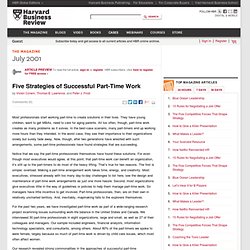

Five Strategies of Successful Part-Time Work. Most professionals start working part-time to create solutions in their lives.

They have young children, want to get MBAs, need to care for aging parents. All too often, though, part-time work creates as many problems as it solves. In the best-case scenario, many part-timers end up working more hours than they intended. In the worst case, they see their importance to their organizations slowly but surely fade away. Now, though, after two generations have wrestled with such arrangements, some part-time professionals have found strategies that are succeeding. Notice that we say the part-time professionals themselves have found these solutions. For the past two years, we have investigated part-time work as part of a wide-ranging research project examining issues surrounding work-life balance in the United States and Canada. Our research revealed strong commonalities in the approaches of successful part-time professionals. Go Paperless: Stop Printing Everything and Enjoy the Digital Life. The “paperless office” we were promised never seems to arrive for many people.

The reality, however, is that a paperless office is here today if you want to take advantage of it. If you’re still someone who prints emails, web pages, and other documents, you can stop now. There are better ways to keep track of your information and access it more quickly — you can’t search for words on physical pieces of paper, after all. The Case Against Printing Printing is costly and inconvenient, requiring often-expensive ink cartridges, printer paper, and new printers when that cheap inkjet printer inevitably fails. Printing was necessary when computers were heavy bricks that sat attached to desks. How Not to Print We geeks may have stopped printing long ago, but there are many people out there who still print emails and web pages regularly.
Create a Digital File Cabinet: First, you’ll want to decide where you’ll save things instead of printing them. Punctuality. Punctuality is the characteristic of being able to complete a required task or fulfill an obligation before or at a previously designated time.[1] "Punctual" is often used synonymously with "on time".

It is a common misconception that punctual can also, when talking about grammar, mean "to be accurate". According to each culture, there is often an understanding about what is considered an acceptable degree of punctuality.[2] Usually, a small amount of lateness is acceptable; this is commonly about ten or fifteen minutes in Western cultures, but this is not the case in such instances as doctor's appointments or school lessons.[3] In some cultures, such as Japanese society, and settings, such as military ones, expectations may be much stricter. See also[edit] References[edit] External links[edit] Kaushik Basu, Jörgen W. Pomodoro Technique. Time management method A Pomodoro kitchen timer, after which the method is named. The Pomodoro Technique is a time management method developed by Francesco Cirillo in the late 1980s.[1] The technique uses a timer to break down work into intervals, traditionally 25 minutes in length, separated by short breaks.
Each interval is known as a pomodoro, from the Italian word for 'tomato', after the tomato-shaped kitchen timer that Cirillo used as a university student.[2][3] The technique has been widely popularized by dozens of apps and websites providing timers and instructions. Closely related to concepts such as timeboxing and iterative and incremental development used in software design, the method has been adopted in pair programming contexts.[4] Description[edit] There are six steps in the original technique: For the purposes of the technique, a pomodoro is the interval of time spent working.[1] Cirillo suggests: Tools[edit] Variations[edit] There are many variations on the Pomodoro Technique.
Daymond John's lessons on the value of time. (MoneyWatch) Celebrated entrepreneur Daymond John knows how to use his money to make more money: He mortgaged the home he shared with his mother to seed his FUBU clothing brand, turning a street-corner business into a fashion powerhouse with annual sales of more than $350 million.

But John also knows that no matter how much money he makes, he can't make more time. John, who's also known to millions as one of the mogul investors on TV's "Shark Tank," quickly turns down otherwise promising, attractive investments and projects when he feels they won't make the best use of his time or expertise.
His disciplined approach -- and the school of hard knocks lessons he's learned -- serve as valuable real-world examples for new entrepreneurs, and even some with a few miles behind them. Recently I had a conversation with John about his views on using and investing his time, along with about how he maintains that discipline now that he is involved in a variety of businesses and other pursuits.